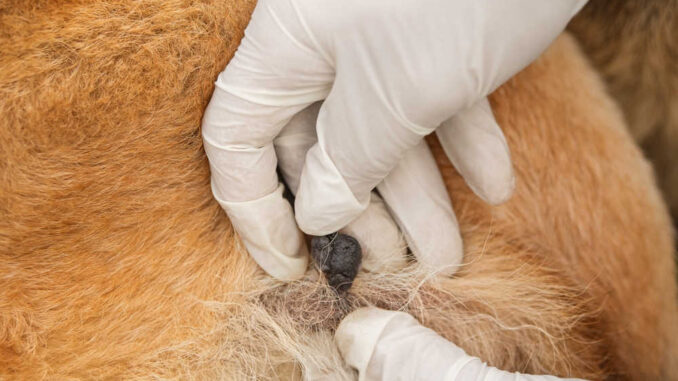
This article was updated on October 18th, 2023

It can be concerning to see a new black lump on your dog, particularly because black growths may mean cancer in human medicine. When I worked as a veterinarian, I encountered various causes for black bumps on dogs: some were cancerous, but others were benign and nothing to worry about. Let’s look at the most common types – with pictures selected by our veterinarians.
6 most common types of black lumps or bumps [with pictures]
1. Warts or adenomas
✓ Very common, mostly in senior dogs
Warts, caused by canine papillomavirus, and adenomas are some of the most common types of small lumps on dogs. These masses are benign, irregularly shaped like cauliflower, and usually pale in appearance. Below are two examples of black warts. Notice the irregular, raised shapes:
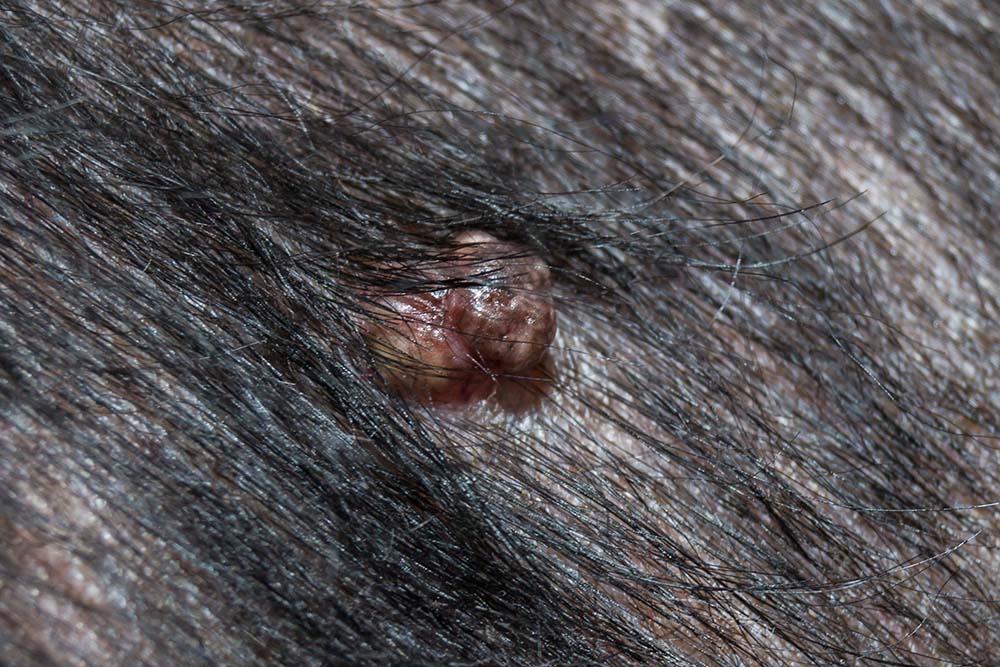
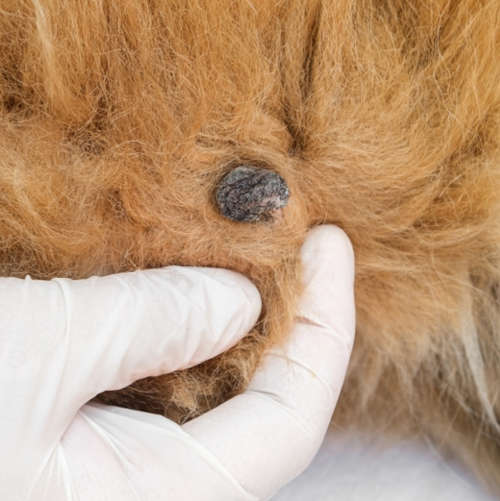
Although warts and adenomas are not a major concern, they can become infected or ulcerated. When warts become inflamed or infected, blood or pigment can turn the bumps dark. When warts become problematic, the treatment of choice is surgical removal.
Learn more about Warts (Pictures & Treatments).
2. Skin tags
✓ Very common
Skin tags are benign fibrous growths that usually occur in high-friction areas on your dog’s skin. With a variable appearance, tags may look like raised bumps or attach to the body on a narrow stalk. They appear with or without hair. Skin tags are very common in dogs and can sometimes be black.
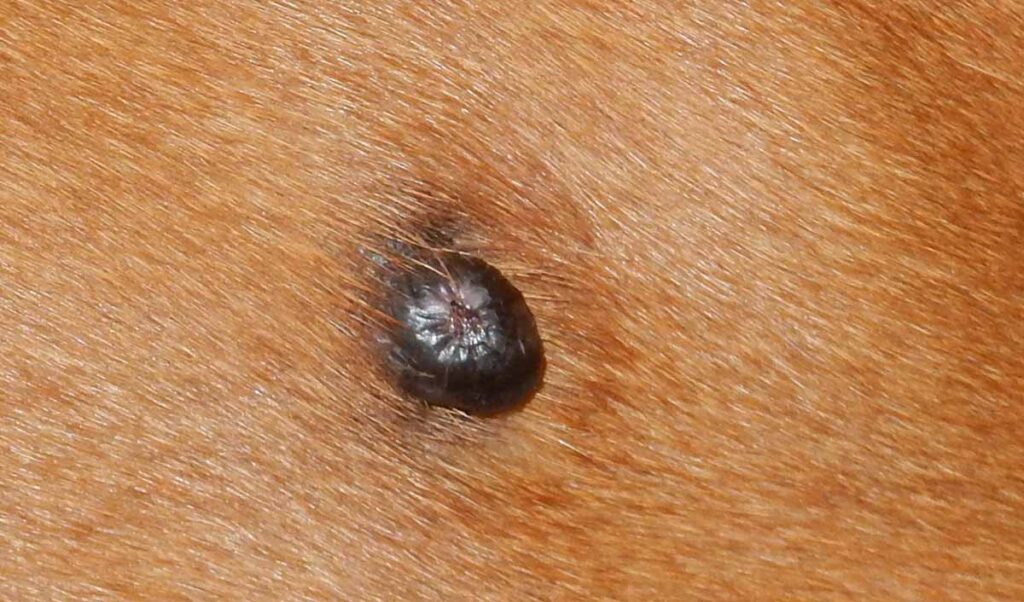
You may suddenly see a new skin tag on your dog, but they usually take time to develop. They are generally harmless but can become irritated and painful from constant rubbing. As long as your dog isn’t bothered, skin tags can be left alone. You should also contact your veterinarian if you notice any changes in color, shape, or size.
Learn more about Skin Tags: Pictures, Diagnosis, Treatment.
3. Histiocytomas turning black over time
✓ Very common, mostly in younger dogs (up to 3 years old)
Histiocytomas are benign, dome-shaped lumps that arise when immune cells (histiocytes) overgrow. They suddenly appear on the face, ear flaps, or legs, can grow rapidly, and may ulcerate. Although histiocytomas are normally red/pink in color, they can turn black over time, as shown on the picture below:
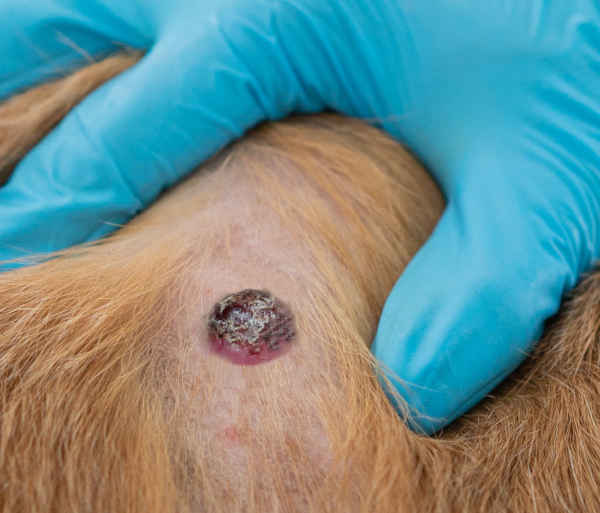
If you have a young dog that develops a histiocytoma, discourage him from licking, chewing, or scratching the bump. This will help to prevent inflammation, infection, and ulceration.
Most histiocytomas will resolve spontaneously in 1-3 months without treatment.
Learn more about Histiocytomas.
4. Cancerous tumors: melanomas
Melanomas are malignant growths that appear as black or dark lumps, often found in older dogs on their lips or mouth (as shown on the images below). When pigment-producing cells known as melanocytes grow proliferatively, they usually create brown or black lumps because the cells contain melanin granules.
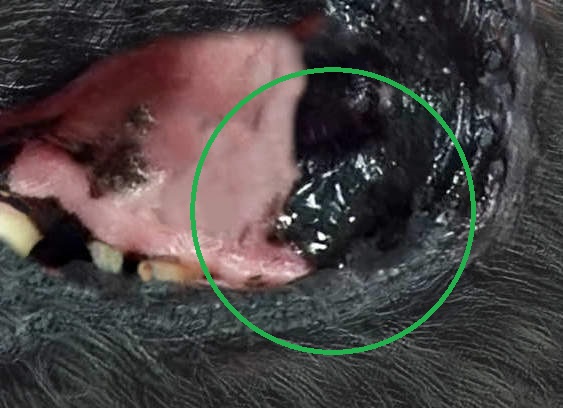
These tumors often grow rapidly and spread quickly to other parts of the body.
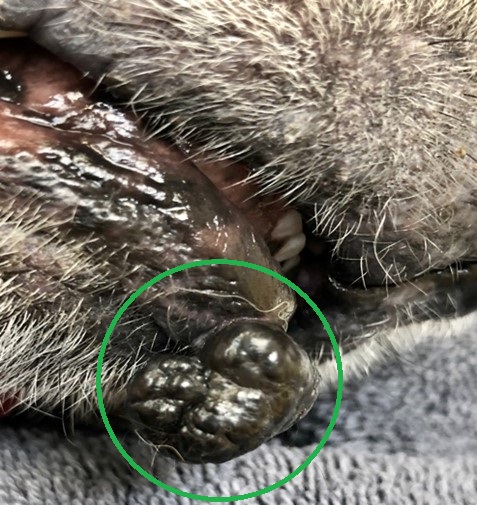
Photo: Ian Brett Spiegel VMD, MHS, DACVD
Black or dark cancerous lumps:
Cancerous lumps tend to grow quickly and in an unpredictable manner, which often results in an irregular shape. This is illustrated by the black lumps in the two pictures below:
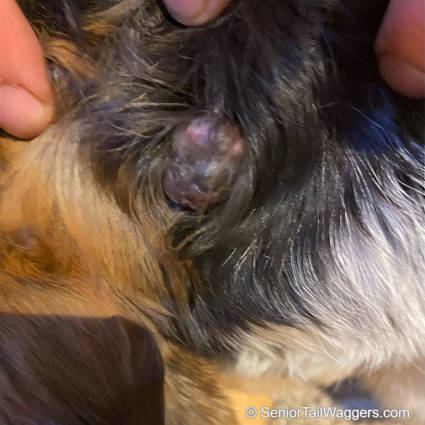
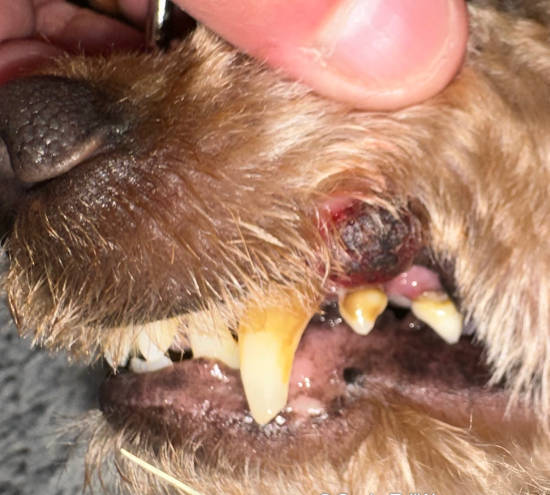
Early diagnosis and treatment are important because they significantly impact your dog’s diagnosis. The primary method to treat melanomas is the surgical removal of the tumor along with surrounding tissues that may be affected. Learn more about Melanomas (Pictures & Treatments).
If a lump or lesion appears red, black, or generally unhealthy in appearance, it may be more likely to be malignant. Cancerous lesions and lumps are also often harder and firmer to the touch. However, keep in mind that it is generally not possible to tell if a lump is cancerous or not just by looking at it: a biopsy is generally needed (more information regarding this is provided later in this article).
5. Darker ticks
Some embedded ticks can mimic black bumps when you see them on your dog’s skin. Depending on where you live, some common ticks on dogs include deer ticks, American dog ticks, and Lone Star ticks. If you find an embedded tick on your dog, you may remove it at home or have your veterinarian extract the parasite.
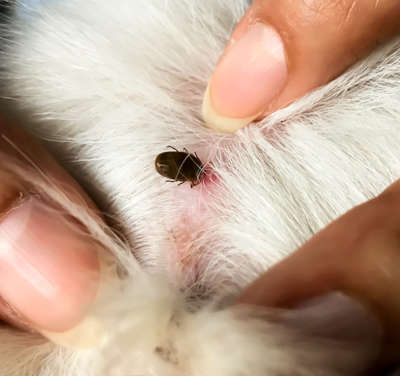
To remove a tick, use fine-tipped tweezers and grasp the pest as close to your dog’s skin as possible. Pull the tick straight out with gentle, steady pressure. Avoid twisting, as you may break off the head, which can cause infection. Once the tick is out, examine it to make sure you have the entire body, then disinfect/wash the bite area.
6. Hygromas
Hygromas typically form on the bony prominences of large dogs who lie on hard surfaces like pavement or tiles. They form in an effort to protect the dog’s skeleton and to minimize friction. In the photo below, the dog has a hygroma on the elbow and the fur above it is missing; this would be quite typical:
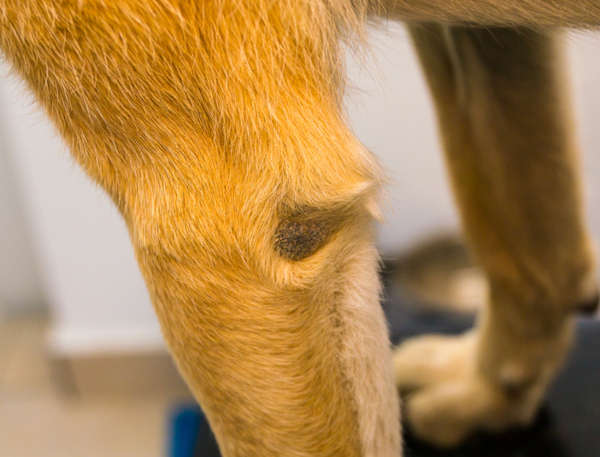
Hygromas
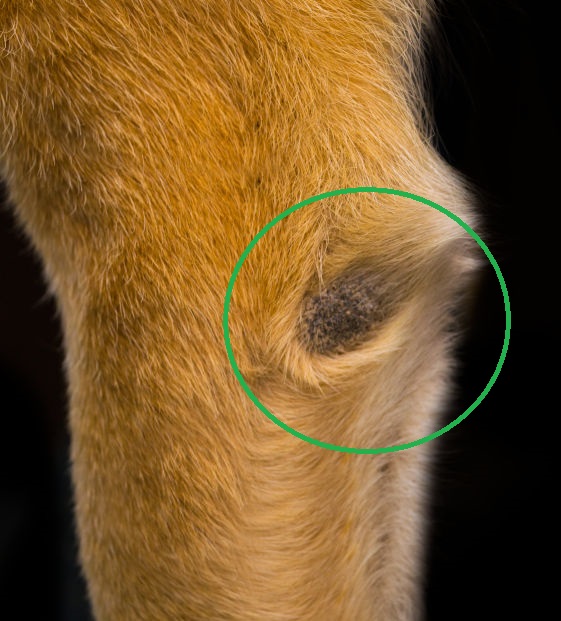
Does your dog’s black lump look different?
View pictures of 12 common lumps and bumps in dogs.
A biopsy is generally needed to confirm the nature of a lump
When owners bring their dogs to our clinic because of a black lump, we typically perform a physical examination and run tests that may include:
- evaluating the characteristics of the mass including size, shape, depth, and more
- taking a fine needle aspirate or biopsy and submitting it to the lab for analysis
- running bloodwork to check for endocrine disorders or signs of infection
- skin scrapings or hair samples if we suspect issues such as mites or skin infections
- impression smears to help diagnose the cause of scabs
Estimated cost of diagnosis
Depending on your dog’s particular situation, your vet may want to charge the following:
- office visit and initial exam – approximately $50-100
- bloodwork – $150-300 in most cases
- aspirate, skin scrapings, or impression smears with cytology – $25-250
- biopsy with pathology – $300-600
- bacterial or fungal cultures – $300-400
Why are some lumps black?
Bumps or growths on dogs can be black mostly because they are one of the following:
- blood-filled lumps: when a dog’s skin experiences trauma, blood may collect at the point of injury. Over time, the blood dries and turns reddish-brown or black, like a scab.
- tumors: whether the growth is benign or malignant, it may collect pigment granules known as melanin that turn the bump black. They often appear in response to skin inflammation, but the cells that produce melanin sometimes turn cancerous, causing malignant black tumors (known as melanomas).
Top causes of black spots or scabs on the skin
Below, we’ll look at various reasons that black spots, scabs, or raised, itchy patches of dark skin may suddenly appear on your dog.
1. Hyperpigmentation
When your dog’s skin is traumatized, melanocytes produce extra pigmentation to protect the damaged areas – resulting in black spots on your dog’s skin. Common causes of hyperpigmentation include injuries, allergies, parasites, aging changes, cancer, or endocrine disorders like Cushing’s disease or hypothyroidism.
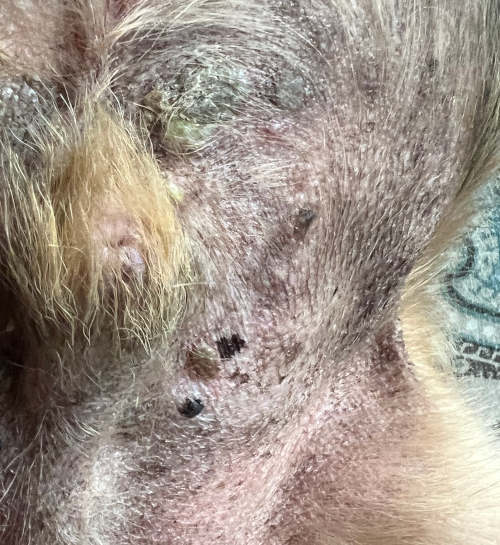
If your senior dog develops black patches or spots on his skin but there aren’t any other changes, it’s probably age spots. However, you should contact your veterinarian if there are other changes to the skin like:
- scaliness
- thickening
- roughening
- itchiness
- crustiness
- redness around the margins
These symptoms often indicate an underlying condition that requires treatment.
2. Injury
Injuries such as scrapes or cuts are the most common cause of black scabs in dogs. When the skin surface is traumatized, it seeps blood and platelets. A clot forms and dries to form a protective covering over the skin. Over time, the scab turns dark brown to black.
As long as the scab doesn’t turn yellow or become infected, and your dog leaves it alone, you can let the skin heal naturally. If your furbaby continually licks and abrades the area, you may need to use an E-collar to protect the wound from further irritation.
3. Allergies
When your dog reacts to a food-based or environmental allergen, he can develop an allergy skin rash or hives. At first, the skin will be red and irritated, but if the inflammation is chronic, the area may become thickened, darkly pigmented, and form black or dark scabs from incessant itching.
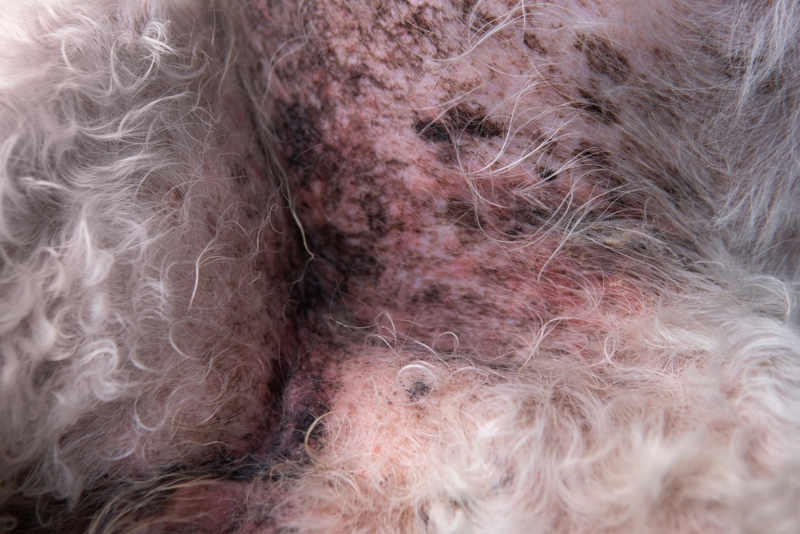
If your dog has chronic allergies, consult with your veterinarian. He may benefit from steroid treatment or a hypoallergenic diet.
4. Parasites
External parasites like fleas and mites can cause black scabs or spots on your dog. Fleas usually jump on your dog to feed and often leave behind flea dire (feces) that resemble tiny black scabs. Additionally, their bites can trigger an allergic reaction known as flea bite dermatitis that can leave black scabs.
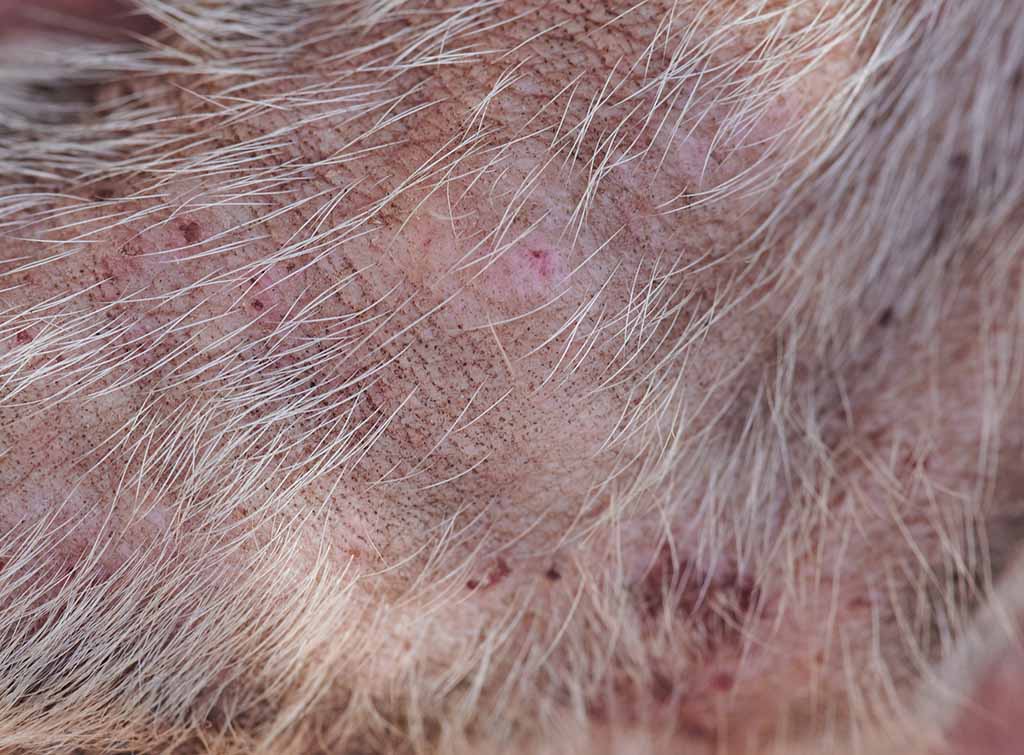
On the other hand, mites tend to burrow under your dog’s skin, causing inflammation and irritation. As a result, your pup will scratch or chew the area continuously and cause skin trauma and scabbing.
To prevent skin issues from external parasites, keep your dog up-to-date on preventative treatments for parasites. If you suspect that your dog has mites or fleas, contact your veterinarian.
5. Skin infections
Skin infections in dogs are usually caused by Staphylococcus spp. bacteria or fungal infections(most commonly ringworm or yeast). These conditions irritate the skin and cause inflammation that can lead to scabbing or hyperpigmentation.
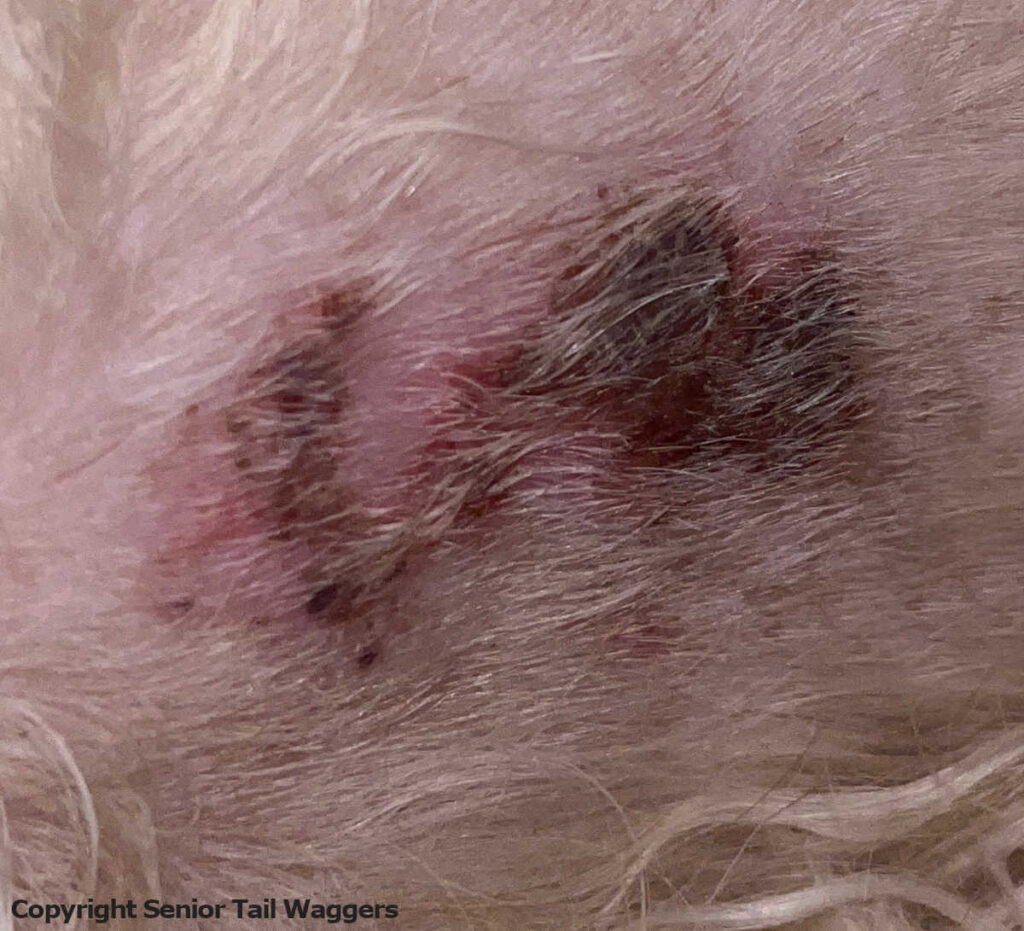
Skin infections should be examined by your veterinarian to properly diagnose the underlying cause and administer the appropriate treatments. Depending on the type and severity of the infection, your veterinarian may prescribe topical treatments, antifungal medication, or antibiotics.
Learn more about black spots on dog skin or black scabs on dogs (with more pictures and advice from our veterinarian team).
Learn more about lumps and bumps on dogs:
Disclaimer: This website's content is not a substitute for veterinary care. Always consult with your veterinarian for healthcare decisions. Read More.







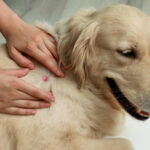
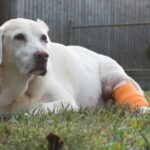




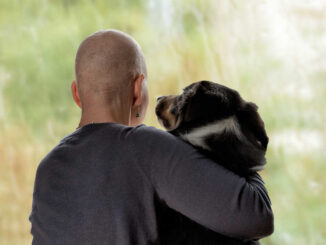
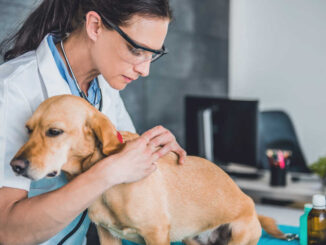
Be the first to comment